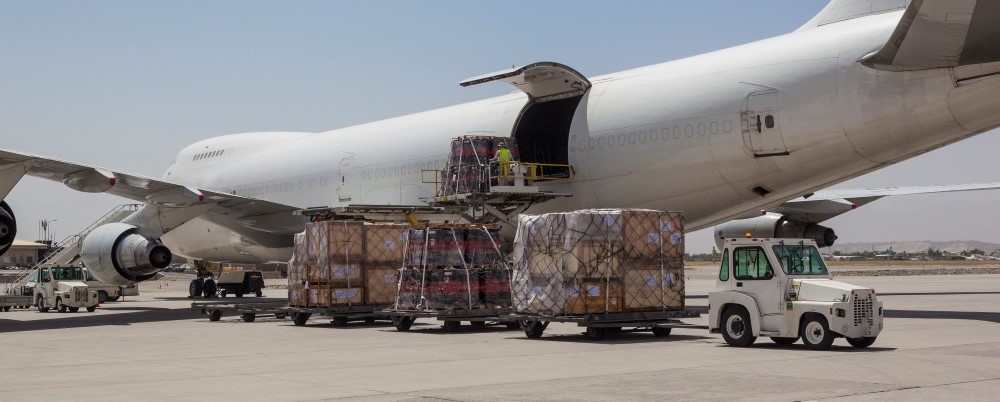The demand for cold chain logistics is growing due to several parallel changes on the market. The last years have seen a rise of temperature-sensitive biopharmaceuticals and biosimilars. Simultaneously, with a growing middle class and higher income levels, there is an increasing demand from emerging markets for more advanced medications. In addition, stricter regulations as well as an increased supply of very sensitive and personalized products put higher demands on safe, temperature-controlled transport. This guide gives you the essentials of pharmaceutical cold chain logistics in today’s changing environment.
Table of contents
Rapidly changing conditions for temperature-controlled pharma logistics
- Megatrends that influence the pharmaceutical cold chain
- Cold chain logistics – complexity and challenges
- Cold chain logistics and risk management
Choosing the right temperature-controlled transport for sensitive pharmaceuticals
- Choosing between active and passive containers/packaging
- Market circumstances that can impact the choice of transport solution
- Internal requirements surrounding cold chain logistics
Make your cold chain logistics operations predictable
- Active containers that safeguard your products
- Data services that help you plan, execute, and improve your logistics
- Improve cost-efficiency and predictability of your shipments
Rapidly changing conditions for temperature-controlled pharma logistics
Megatrends that influence the pharmaceutical cold chain
- The increase of sensitive biopharmaceuticals is driving the need for tailored and reliable cold chain solutions. These products are not only sensitive to temperature fluctuations but also to shock and vibration, humidity, light, and other ambient factors.
- The market for specialized medicine, not least insulin, is growing rapidly in emerging markets, which puts pressure on the cold chain to handle huge volumes of sensitive products that often have a short shelf life.
- Regulatory requirements have become stricter, with the European Union in the lead with its Good Distribution Practice, GDP. A similar set of regulations is under development in the US and China has recently implemented its Good Supply Practice of Pharmaceutical Products. In addition, the US Food and Drug Administration, FDA, requires transport details in filings for a new product.
- Temperature-controlled transport does not only imply a temperature range between 2-8°C (refrigerated). In the last years there has been an increased demand for cold chain solutions at other temperature ranges such as controlled room temperature (20°C-25°C, with acceptable excursions to 15°C and 30°C).
- The global increased incidence of diabetes and other diseases of the metabolic syndrome are driving the demand for constantly increasing volumes of products that need temperature-controlled transport, such as insulin. At the same time, the development of extremely low volume, personalized gene therapy is driving the need for completely different cold chain solutions.
- New technology will help solving many challenges of cold chain logistics. However, with new technology and possibilities of better control come even stricter regulations from regulatory bodies that all stakeholders in the pharmaceutical cold chain must keep up with.

Cold chain logistics – complexity and challenges
Temperature-controlled transport of sensitive pharmaceuticals poses many challenges. Pharmaceutical cold chain has many handover points, each of which has its own inherent weaknesses that can potentially threaten the quality and safety of the delivery. A good understanding of the cold chain, coupled with extra safety margins and proper risk management, is needed to ensure that the products reach patients intact. Below is an overview of the specific characteristics and challenges of pharmaceutical cold chain logistics.
Sea freight versus air freight
In the last years, cold chain logistics of pharmaceuticals via ocean has grown in popularity as it is often cheaper than air freight and is seen as a more environmentally friendly choice. This trend is however counteracted by the increased number of biopharmaceuticals that are introduced on the market. For products that need temperature-controlled transport as well as products with a short shelf life, sea freight is not a viable option. In case of delays, air freight delivery can often be rerouted within a day or even hours whereas shipments can be stuck for days or even weeks on ocean vessels or at seaports. Delivering sensitive pharmaceuticals via air thus carries a much lower risk and is therefore the preferred choice for most of the new and precious products that are entering the market – biopharmaceuticals and gene therapies. It is also the preferred choice for products with a low or no stock on the market, such as at a New Product Introduction or personalized medicine.
Booming e-commerce a new competitor for space
For many years, pharmaceuticals have been high priority cargo for airlines. Steady sales and high margins, as well as constantly growing sales, have resulted in good business. The booming e-commerce has however made pharmaceuticals less interesting for airlines. Even though airlines can charge a better price for temperature-controlled delivery of pharmaceuticals, it also comes with a much higher risk. Compared to pharmaceutical companies, consumers are much more willing to pay a premium price for speedy delivery, especially at peak season. With the huge and growing volumes of e-commerce, pharmaceutical companies can expect to have to compete more for space in the aircraft.
Making the right choice: active or passive transport solution
With more sensitive pharmaceuticals being launched, and with stricter requirements from regulatory bodies, it has become increasingly important to find the right packaging solution for each product. When deciding on the specific packaging or container for temperature-controlled transport, the choice is between an active or passive solution.
Passive packaging can be likened to an insulated box. The insulation material can be dry ice or phase change materials. Another type of passive solution is thermal blankets that can give a temporary protection for example when the shipment is on the tarmac before being loaded onto an aircraft. Passive packaging can keep the products at a specific temperature range for a certain period of time but after that, the products must be repacked in order to maintain a specific temperature. Passive packaging does not adjust the temperature inside the packaging according to the ambient temperature. Passive packaging usually has to be pre-conditioned before use.

Active packaging, or an active container, can be liked to a movable refrigerator. The cooling technology is either compressors or dry ice. Active containers can adjust the temperature inside the container according to the ambient temperature. Active containers that use compressors can both heat and cool the inner temperature whereas containers that run on dry ice are used for cooling. Active containers can keep the products at an exact temperature range as long as they are recharged or refilled with dry ice. They are therefore a much safer alternative for temperature-controlled transport compared to passive packaging. Another advantage of active containers is that they are usually certified Unit Load Device, ULD, and can be carried directly on board the aircraft. Active containers do not have to be pre-conditioned before use.
|
|
Beyond 2-8°C – temperature-controlled logistics for pharmaHow to secure shipments of temperature-controlled transport. |
|
How air cargo prioritization affects delivery
First of all, if the products are not labeled as pharmaceuticals, they will be shipped as general cargo, that is, as the least prioritized cargo. Passive packaging is also usually shipped as general cargo. Active containers often get prioritized cargo status and will therefore be a safer alternative in this respect (in addition to the safer cooling/heating technology).
If the aircraft is full, less prioritized goods will be bumped off (ultimately it is the pilot who decides what gets loaded on the aircraft). Passenger and passenger bags have the highest priority, with aircraft materials, human remains, and live animals are next in line. Then come small packages and e-commerce and after that come pharmaceuticals. Least prioritized is general cargo. The exact order can of course vary somewhat but it is clear that pharmaceuticals compete for space with e-commerce.
Cold chain logistics and risk management
Risk management is essential when planning for temperature-controlled transport of sensitive pharmaceuticals. As mentioned previously, cold chain logistics involves many handover points and there are also many stakeholders involved in bringing the products from the production site to patients in need. This increases the risk of human errors and misunderstandings along the way.
In addition to the many people that will haul, load, and unload the products, air freight (as well as ocean freight) is exposed to a number of other factors that can delay or threaten to damage the pharmaceuticals such as labor strikes, customs delays, difficult weather conditions, traffic jams to and from the airport, as well as force majeure circumstances such as volcano eruptions, terror attacks, and war. This means that you will need to develop contingency plans as well as plan with a certain safety margin should anything go wrong. At a New Product Introduction or, for very specialized products, there is no available stock on the market whereby these kinds of deliveries must be planned thoroughly. Development costs of new pharmaceuticals, not least the growing amount of biopharmaceuticals, are extremely high and a failed introduction due to transport delays can have a significant negative business impact.

The complexity and risks of temperature-controlled shipments vary in the different stages of a product’s life cycle. This article details the specifics for each stage.
Controlling the cold chain in an increasingly regulated environment
Regulatory bodies all over the world are introducing more and stricter regulations and guidelines when it comes to transport of medicines. The pharmaceutical companies are responsible for ensuring that all stakeholders in the complex cold chain comply with regulations. This means that pharmaceutical companies must control whether ground handling agents, forwarders, personnel at the airport and at cold storage facilities, truck drivers that carry the goods to and from the airport and, not to forget, the airline employees, have received proper training and are able to handle the shipment according to guidelines.
Ground handling agents and airline staff working on the tarmac often have a high employee turnover, meaning that training in handling packages and containers as well as in GDP and other regulations and guidelines must take place at regular intervals.
It is good to keep in mind that things will differ at the place of departure compared to the place of destination. Regulations, people, and the way of doing things will not be the same. Another thing that will also differ is available resources – temporary warehousing, availability of containers, and people with the right training and experience.
Monitoring and evaluation of your shipment
Data collection and monitoring are key to analyze and continuously improve temperature-controlled shipments. Historical data can be used to qualify a shipping solution, thereby speeding up the validation process. For active containers, the temperature can be monitored in real-time and actions be taken if necessary. Both active and passive containers can use sensors to log the temperature inside the packaging/container during shipment, which can then be analyzed to identify weak points of the cold chain. Active containers can also track other events, such as door openings and shock and vibration. Data is used to an increasing extent to secure temperature-controlled deliveries of sensitive pharmaceuticals, with logistics providers introducing new technologies and innovative services.
|
|
Different alternatives for temperature-controlled transportWhat to consider when choosing a transport solution. |
|
Choosing the right temperature-controlled transport for sensitive pharmaceuticals
Huge costs are involved when transporting pharmaceuticals across the globe. Temperature-controlled transport is a high-risk operation where both the patient's life and the pharmaceutical company's reputation could be at stake.
The actual costs of delivery only make up a few percentages of the total value chain of a pharmaceutical – from development and production until it reaches patients. Whereas the cost of transport is comparatively low, there are a lot of things that can go wrong in the cold chain, which can have a huge impact for the business. Choosing the right partners and the right transport solution – to the right price – becomes essential. Pharmaceutical companies must choose carefully and constantly evaluate its partners to safeguard their products. This section presents what to consider when choosing temperature-controlled transport for sensitive pharmaceuticals.
Choosing between active and passive containers/packaging
As described above, active containers can be compared to movable refrigerators. When refilled with dry ice or recharged, they can keep a specific temperature interval indefinitely.
There are different varieties of passive packaging. Thermal blankets can protect the products temporarily, whereas insulated boxes, containing dry ice or phase change materials, can keep a specific temperature range for a certain amount of time. As passive packaging has no active temperature control, that is, it cannot adjust the temperature inside the packaging according to changes in the ambient temperature, passive packaging carries a higher risk should the shipment be exposed to delays or extreme temperatures.

Apart from these obvious differences between active and passive transport solutions there are other aspects that differentiate the two temperature-controlled solutions:
- Leasing active containers or buying passive packaging?
Active containers are leased and will be delivered to the customer in time for the delivery. Passive packaging must be bought in advance and must often be preconditioned to the desired temperature before shipment. Active containers can be reused for 10-15 years whereas passive packaging must often be scrapped after delivery. This means that the pharmaceutical company and/or the logistics provider must plan for the correct waste management. Especially when shipping to emerging markets there is a risk that the waste material ends up in landfills. - Less weight per shipment or more products shipped?
Both weight and volume matter when shipping by air. A higher weight will contribute to a higher amount of fuel needed, as well as increased emissions of carbon dioxide. As active containers often weigh more than passive packaging, this would imply that using active containers is more expensive and less environmentally friendly than passive solutions. On the other hand, insulation materials for passive packaging take up a lot of space. With passive packaging, fewer amounts of products will therefore be shipped in relation to the packaging/container. This means that more shipments must be made, which will increase the environmental impact, in addition to the increased amount of waste material. Your logistics provider can help you optimize shipment loading and calculate which alternative is best for you. For precious and sensitive pharmaceuticals, an active transport solution is the only viable choice.
|
|
Total Landed CostIn the competitive and cost-conscious market of today, it is vital to have a good understanding of the pros and cons of different shipment solutions to achieve operational excellence over the lifetime of a product. |
|
- Network and handling of containers
When leasing an active container or procuring passive packaging, suppliers must have the capacity and network to provide you with adequate service from start to end of the cold chain. As mentioned earlier, there are a lot of differences not only in regulations across the globe but also in available resources for temporary warehousing at the airport and trained personnel who know how to handle the containers. This becomes more acute when shipping in extreme temperatures.
|
|
The keys to succeed with pharma cold chain transportation from MexicoHow to learn the local prerequisites and specific challenges. |
|
- Securing transport data for continuous improvement
New technology has made it easier to access transport data. There are several kinds of data that can assist you in safeguarding your products all the way to the patients:
– The service provider should be able to provide you with historical data on similar shipments to support you in validating the shipment solution.
– Logging of ambient temperatures and the temperature inside the container will help you analyze the shipment and identify weak spots or any other potential threats to the integrity of your products. If you use active containers you will also be able to log other aspects of the shipment, such as door openings and recharging of batteries. Continuous improvement is often included in regulatory guidelines and this kind of data will be needed to keep up with the increasingly regulated environment that surrounds temperature-controlled transport.
Market circumstances that can impact the choice of transport solution
Changes in the market imply that more things must be considered when planning for the right temperature-controlled transport solution.
Pharma is competing with e-commerce for space in aircrafts
Pharma and e-commerce are competing for space in aircrafts. During normal market conditions (e.g. pre COVID-19) e-commerce can be up to four times as profitable for airlines compared to pharmaceuticals and is much less risky. Pharmaceuticals are steady business for airlines but consumers are much more willing to pay a higher price for express delivery. The airline priority list is a good illustration of where the market is going with the fast growth of e-commerce. The exact order can of course vary.
Airline Priority1. Passengers |
The list is of interest when the aircraft is full, as less prioritized cargo may be bumped off. If you want your shipment to be prioritized it has to be labeled as pharmaceuticals. Passive packaging is usually handled as general cargo whereas active containers have a higher priority.
End of the year sales are threatened by the e-commerce peak season
Deliveries of pharmaceuticals at the end of the year are particularly sensitive to delays, as most pharmaceutical companies want to include the sales in their annual reports. In addition, they must ensure that stocks in local markets are full before the holiday season. This critical period for pharmaceutical companies coincides with the peak season for e-commerce. In the worst case your shipment will be delayed or rerouted as Christmas presents pay much better than your life saving products. This challenge must be taken into account when scheduling temperature-controlled transport.
Internal requirements surrounding cold chain logistics
Internal stakeholders will likely have slightly different views on what constitutes the best cold chain logistics solution. Below are typical concerns of the quality management, regulatory, and procurement functions:
- Quality management: Risk management is a strategic way of identifying and managing risks. Thorough risk management leads to fewer mistakes, fewer human errors, and will eventually save costs and protect the company’s core business. A risk-based thinking is also included in regulations such as ISO 9001:2015. In spite of the fact that transport only makes up a small part of the value chain of a pharmaceutical product, it carries a certain amount of risk, not least because the pharmaceutical company has to rely to such a high degree on external partners.
- Quality management and regulatory: According to guidelines from the FDA, information on the transport solution must be included in the phase 3 filing for a new product. Many guidelines also include clauses for continuous improvement. Thus, quality management is an important factor when choosing a transport solution.
- Procurement: Cost management and the company’s procurement process will have a major impact on your transport options. The last years have seen a shift of procurement from primarily being a cost cutting function within companies to work instead as an internal consultant to the business units. However, the role of the procurement function differs in different companies.

Make your cold chain logistics operations predictable
Temperature-controlled transport of sensitive pharmaceuticals involves a certain amount of risk. There are many stakeholders involved, rapid changes on the market, new regulations, and not least the usual risks that come with any kind of transport – delays, strikes, and bad weather. Nonetheless, pharmaceutical companies must plan for their shipments with a high degree of predictability to safeguard that the products will be delivered to patients in time and in perfect condition.
At Envirotainer we have more than 35 years’ experience and expertise of supplying secure cold chain solutions. Temperature-controlled transport of precious pharmaceuticals involves a range of different activities, besides the actual container. We therefore offer a number of associated services such as load optimization, cost-efficiency such as volume/weight ratio, data services, and a network of partners and container stations.
In this section you can read about our extensive range of services that will enable you to achieve a predictable temperature-controlled delivery of your sensitive pharmaceuticals.
Active containers that safeguard your products
We offer several different types of active containers and associated services to help you with your shipments. Below is a short summary of our containers.
All our containers have FAA (Federal Aviation Administration) and EASA (European Aviation Safety Agency) approval.
RAP e2 and RKN e1 containers
Our active e-containers run on electricity and use both heating and cooling technology to keep the inside temperature at a specific range at almost any ambient temperature. The e-containers are used for pharmaceuticals that must be kept at temperatures of 0°C or above.
The RAP e2 container can load 5 Euro pallets or 4 US pallets. The RKN e1 container is a pallet-sized container. The containers are certified Unit Load Device (ULD), which means that they can easily be loaded onto an aircraft and get prioritized cargo status.

RAP t2 and RKN t1 containers
Our active t-containers run on dry ice and have a cooling range of approximately -20°C to +20°C (depending on the ambient temperature). The t-containers can be used for pharmaceuticals that require less data insights for all temperature ranges, including shipments that must be kept deep-frozen.
The RAP t2 container can load 5 Euro pallets or 4 US pallets. The RKN t2 container is a pallet-sized container. The containers are certified ULD and therefore get prioritized cargo status.
With more than 6,000 containers we have the largest fleet of temperature-controlled containers on the market. This means that we can guarantee a high level of availability and support to customers worldwide, also in the case of very large shipments. We have been running at 100% availability of units across the entire globe for the last 18 months, which means we have been able to meet every single customer request for a unit.
|
|
Our ContainersTo be sure we can meet your needs, we provide rentals of a wide range of temperature-controlled containers worldwide. |
|
Data services that help you plan, execute, and improve your logistics
Our data services help you plan, execute, and continuously improve your logistics operations. The data available from shipments and made available for you can be divided into two categories:
- Pre-shipment data that supports you in qualifying your transport solution.
- Post-shipment data within 48 hours of shipment that can be used to release cargo from customs as well as to analyze and improve operations.
Planning, set-up, and qualification of your shipment
With a fleet of more than 6,000 containers, we have throughout the years collected a lot of transport data. This data forms the basis of our Technology Transfer Package, TTP. The TTP pack can be used for a speedy process when qualifying your transport solution. If needed, we also have two environmental chambers where different shipment scenarios can be simulated.
Other services that we supply our customers with before shipment are dry ice calculation and optimal loading of the containers, as well as Total Landed Cost calculations.

Release of cargo, evaluate and improve your shipment
Evaluation of your shipment will help you identify weak parts of the logistics chain and work with continuous improvements, which is often included in regulatory guidelines. The temperature inside the container and battery levels are monitored on a continuous basis throughout the shipment. Our containers also monitor other events such as opening and closing of the container doors. By using our Transport Evaluation you can compare the shipment with a predefined schedule and use the information in your dialog with service providers. Our Shipping Summary Report shows you a visualization of the shipment (trucking, flight, storage etc.) and in case of a temperature excursion you will be provided with suggestions of corrective actions. Our Active Container Data Services give you information on the temperature inside the container, door openings and battery levels – in other words how the container has been handled throughout the cold chain.
|
|
How to LeaseWe offer a variety of high-tech containers, flexible leasing models and unbeatable service packages. |
|
Improve cost-efficiency and predictability of your shipments
Pharmaceutical cold chain logistics is always a balance between risk and cost management. In order to help you make a better-informed decision we offer the following services:
Managing costs
- Support in calculating Total Landed Cost.
- With our Load Optimization Tool you will be able to maximize the amount of products in each shipment – how many boxes that will fit inside the container and how to load it.
- Dry ice calculation by using the Envirotainer Dry Ice Calculator, or contact us for help.
- General advice, such as finding the optimal trade lanes for your specific shipment.
Our network
- With 50+ service stations globally, a fleet of more than 6,000 containers, and covering 300 airports, we have both the capacity and flexibility to handle all kinds of temperature-controlled shipments, from very low volume to high volume all over the world. During the last two years we have helped ship over 1,200,000,000 doses of medicines across the world without a single product loss.
- With our Envirotainer Academy, our partners and personnel along the cold chain are thoroughly trained in handling the containers as well as in relevant guidelines and regulations. Our Qualified Envirotainer Provider Training and Quality program (QEP) has been developed to recognize freight forwarders and airline stations that meet the industry standards as well as proper management of our containers.

